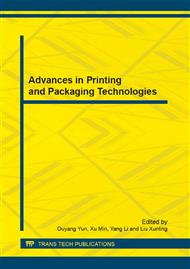p.405
p.410
p.414
p.418
p.422
p.426
p.430
p.435
p.440
Use of Microcapsules of Oregano Essential Oil to Extend the Shelf Life of Strawberries
Abstract:
This work explored the use of microcapsules of natural plant essential oils to increase the shelf life of strawberries during storage. First, antimicrobial tests were performed with selected essential oils to evaluate their antimicrobial capacities against moulds isolated from strawberries. Oregano essential oil was found as strong bioactive agents against moulds from strawberries, whereas cinnamon essential oil had lower antimicrobial properties. Then, microcapsules of oregano essential oil were prepared with oregano essential oil, sodium alginate, Tween 80, and monoglycerides, and their internal structure were observed by SEM, and their oils contain were tested by UV-visible spectrophotometer inspection. Different amounts of microcapsules of oregano essential oil were wrapped into small polypropylene non-woven package, and they were pasted on the internal of corrugated boxes. Finally, freshly picked strawberries were put into corrugated boxes and stored at room temperature (from 16°C to 18°C) for 4 days. The results showed that the use of microcapsules of oregano essential oil could effectively inhibit the decay of strawberries, maintain their quality, and extend their shelf life. Strawberries presented the best quality when the amount of microcapsules arrived at 0.828 grams per 500 grams of strawberries.
Info:
Periodical:
Pages:
422-425
Citation:
Online since:
December 2012
Authors:
Keywords:
Price:
Сopyright:
© 2013 Trans Tech Publications Ltd. All Rights Reserved
Share:
Citation:


